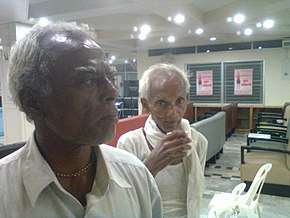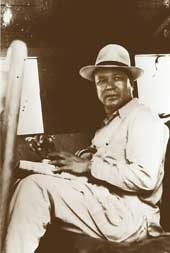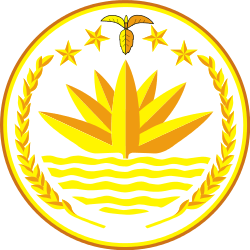Munda people
| Regions with significant populations | |
|---|---|
| 2,228,661[1] | |
| Jharkhand | 1,229,221 |
| Odisha | 584,346 |
| West Bengal | 366,386 |
| 5,000[2] | |
| Languages | |
| Mundari[3][4]:99 | |
| Religion | |
| |
| Related ethnic groups | |
The Munda people (Hindi: मुंडा, Assamese: মুণ্ডা, Bengali: মুন্ডা) are an Adivasi ethnic group of India. They speak the Mundari language, which belongs to the Munda subgroup of Austroasiatic languages. The Munda are found in the northern areas of east India concentrated in the states of Jharkhand, Odisha and West Bengal. Munda also reside in adjacent areas of Bihar, Chhattisgarh and Arunachal Pradesh as well as in portions of Bangladesh. The group is one of India's largest scheduled tribes. Munda people in Tripura are also known as Mura, and in Madhya Pradesh they are often called Mudas.[7]

History
The prehistory of the Munda peoples is obscure. Although how they got to the Chota Nagpur Plateau is disputed, it is agreed upon that the ancestors of speakers of the modern-day Munda languages migrated westward from the Austroasiatic homeland of continental Southeast Asia.
According to R.S. Sharma, a historian of ancient and early medieval India, many Munda, Dravidian and non-Sanskrit terms occur in Vedic texts ascribed to 1500-500 BCE. They indicate ideas, institutions, products and settlements associated with peninsular and non-Vedic India. Similarly, many Pali and Sanskrit terms, signifying ideas and institutions developed in the Indo-Gangetic Plain, appear in the earliest Tamil texts called the Sangam literature, which was created from 300 BCE to 600 CE. The eastern region, inhabited by the Munda, people made its own contribution. Several terms that signify the use of cotton, navigation, digging, sticks, etc. in the Indo-Aryan languages have been traced back to the Munda languages. It is held that changes in the phonetics and vocabulary of the Vedic language can be explained by contact with both Munda and Dravidian languages.[8]
In the late 1800's, the British Raj and many non-Mundas were grabbing land traditionally occupied by Mundas, forcing the Mundas to work as bonded labourers. Munda freedom fighter Birsa Munda began the first protest marches calling for remission of forest dues. He worked to unify the Adivasis of Chota Nagpur resist British rule of India. Millenarianism in the tribal belt started with him, and he is still revered in Jharkhand, with villagers in his home village worshipping him as Birsa Bhagawan.[9]
Culture & tradition
The Munda people probably descended from Austroasiatic migrants from Southeast Asia.[10] Nomadic hunters in the India tribal belt, they became farmers who were employed in basketwork and weaving. With the listing of the Munda people as Scheduled Tribes (Adivasis), many are employed in various governmental organizations (particularly Indian Railways).[11]
Munda religion is a blend of Sarnaism and Christianity, and they are not part of the Indian caste system. Although the Mundas have preserved much of their pre-Christian culture, they have absorbed a number of Christian traditions. They have many folk songs, dances, tales and traditional musical instruments. Both sexes participate in dances at social events and festivals. The naqareh is a principal musical instrument.
The Munda people have elaborate rituals to celebrate birth, death, engagement and marriage. The birth of a boy is celebrated as an earner for the family, and the birth of a girl is celebrated as a family caretaker. Lota-pani is the engagement ceremony. Dali Takka, a monetary gift to paternal guardians, is generally paid before the marriage. Marriage, considered one of the main rituals of life, is a week-long festivity.
An ointment of scented oil and turmeric is applied to the face and body after death. Widow marriage is common. The Munda people are patrilineal, patrilocal and patriarchal.[12]
Involved in agriculture, the Munda people celebrate the seasonal festivals of Mage Parab, Phagu, Karam (festival), Baha parab, Sarhul and Sohrai. Some seasonal festivals have coincided with religious festivals, but their original meaning remains.[13]
Munda people of Jharkhand also follow the old age tradition of Patthalgari i.e. stone erection in which the tribal community residing in the village buries a large inverted u shaped dressed headstone on the head side of grave or entrance of village in which is inscribed the family tree of the dead persons.[14] There are some other types of patthalgari also:-
- Horadiri - It is the stone in which family tree is written.
- Chalpadiri or Saasandiri - It is the stone in remarking boundary of any village and its limits.
- Magodiri - This is the headstone of social criminal who committed polygamy or unsocial marriage.
- Ziddiri - This is the stone placed on over burial of placenta and dried naval part of a newborn. [15][16]
Notable Mundas

- Birsa Munda: late 19th-century freedom fighter
- Anuj Lugun: Poet who received the 2011 Bharat Bhushan Agarwal Award[17]
- Rohidas Singh Nag: Inventor of the Mundari Bani script[18]
- Lako Bodra - Inventor of Varang kshiti script[19]
- Amrit Lugun: Ambassador to Yemen[20] and a South Asian Association for Regional Cooperation director[21]
Literature and studies
Jesuit priest John-Baptist Hoffmann (1857–1928) studied the language, customs, religion and life of the Munda people, publishing the first Mundari language grammar in 1903. With the help of Menas Orea, Hoffmann published the 15-volume Encyclopaedia mundarica. The first edition was published posthumously in 1937, and a third edition was published in 1976. The Mundas and Their Country, by S. C. Roy, was published in 1912. Adidharam (Hindi:आदि धर्म) by Ram Dayal Munda and Ratan Singh Manki, in Mundari with a Hindi translation, describes Munda rituals and customs.[22]
See also
References
- ↑ "A-11 Individual Scheduled Tribe Primary Census Abstract Data and its Appendix". www.censusindia.gov.in. Office of the Registrar General & Census Commissioner, India. Retrieved 2017-11-18.
- ↑ "Mundari Language". Ethnologue. SIL International. Retrieved 20 October 2017.
- ↑ Singh, Geetanjali; Kumar, Jyoti (2014). "Studies on indigenous traditional knowledge of some aquatic and marshy wild edible plants used by the Munda tribe of district Khunti, Jharkhand, India". International Journal of Bioassays. 3 (2). Retrieved 22 October 2017.
Munda tribe...ethnically they are proto- Austroloids and speak Mundari language
- ↑ Osada, Toshiki (19 March 2008). "3. Mundari". In Anderson, Gregory. The Munda languages. New York: Routledge. ISBN 0-415-32890-X.
...the designation Munda is used for the language family. Mundari, on the other hand, refers to an individual language, namely the language of Munda people.
- ↑ "ST-14 Scheduled Tribe Population By Religious Community". Census of India. Ministry of Home Affairs, India. Retrieved 15 October 2017.
- ↑ Srivastava, Malini (2007). "The Sacred Complex of Munda Tribe" (PDF). Anthropologist. 9 (4). Retrieved 22 October 2017.
- ↑ http://tribesindia.com/index.php?option=com_content&view=article&id=792&Itemid=104&lang=en
- ↑ Sharma, R.S. (2006). India's Ancient Past. Oxford: Oxford University Press. ISBN 9780199087860.
- ↑ Pandey, Prashant (2017-09-18). "Jharkhand: Amit Shah launches scheme for villages of freedom fighters". The Indian Express. Retrieved 2017-10-21.
- ↑ Riccio et al. (2011), The Austroasiatic Munda population from India and Its enigmatic origin: a HLA diversity study.
- ↑ "List of Schedule Castes". Ministry of Social Justice and Empowerment, Government of India. 2011. Archived from the original on 23 September 2014.
- ↑ Bhatt, Shankarlal C. (2006-01-01). Land and People of Indian States and Union Territories: In 36 Volumes. Jharkhand. Gyan Publishing House. ISBN 9788178353685.
- ↑ "Mundas, Munda Tribe in Jharkhand India, Occupation of Mundas". www.ecoindia.com. Retrieved 2016-03-26.
- ↑ http://shodhganga.inflibnet.ac.in/bitstream/10603/20515/11/11_chapter%205.pdf
- ↑ https://www.antiquity.ac.uk/projgall/mendaly352
- ↑ https://scroll.in/article/878468/the-constitution-set-in-stone-adivasis-in-jharkhand-are-using-an-old-tradition-as-a-novel-protest
- ↑ "Hindi stalwarts praise tribal poet". in.news.yahoo.com. Archived from the original on 12 November 2014. Retrieved 26 March 2016.
- ↑ "BMS to intensify agitation on Mundari language". www.oneindia.com. Retrieved 2016-03-26.
- ↑ http://www.avenuemail.in/region/tata-steel-celebrated-international-day-worlds-indigenous-peoples/96675/
- ↑ "Sorry for the inconvenience".
- ↑ "Archived copy". Archived from the original on 3 April 2015. Retrieved 23 January 2015.
- ↑ "Mundari: The Language of Munda Tribe".
Further reading
- Parkin, R. (1992). The Munda of central India: an account of their social organization. Delhi: Oxford University Press. ISBN 0-19-563029-7
External links
| Wikimedia Commons has media related to Munda people. |
- Sarna – A case study in religion On the religion of the Munda tribals
- Sinlung – Indian tribes

- http://projekt.ht.lu.se/rwaai RWAAI (Repository and Workspace for Austroasiatic Intangible Heritage)
- http://hdl.handle.net/10050/00-0000-0000-0003-A6AA-C@view Mundari language in RWAAI Digital Archive
